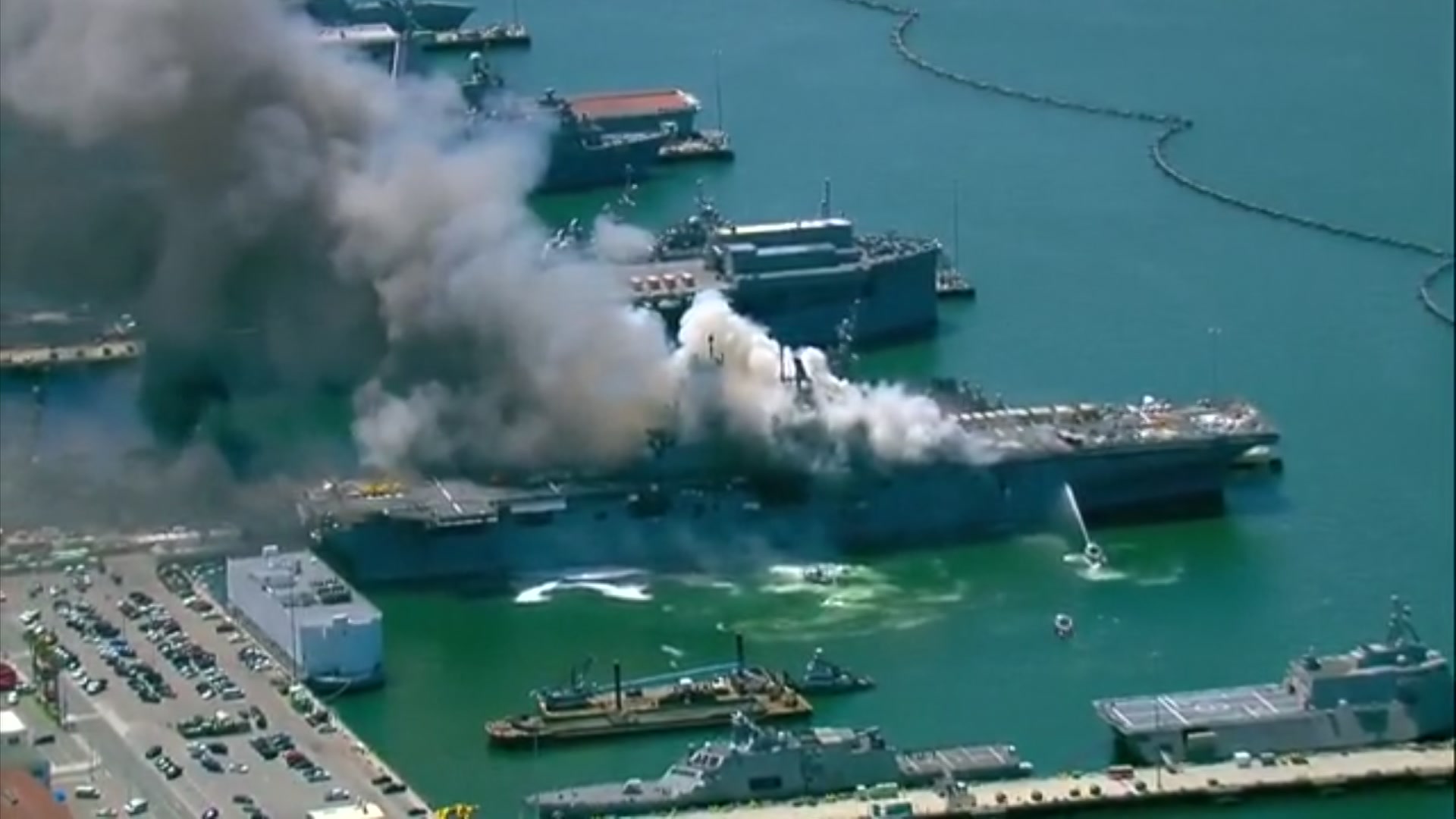A U.S. Navy sailor testified Thursday that Ryan Sawyer Mays was the last person he saw go into a lower vehicle storage area of USS Bonhomme Richard before a massive fire started and burned for days on the ship as it was docked in the San Diego Bay.
The prosecution's key witness, Sailor Kinji Velasco, took the stand on the fourth day of the trial for Mays, who is accused of arson in connection with the fire that destroyed the Navy ship in July 2020.
Velasco said he saw Mays -- who was wearing blue boot camp coveralls and was holding a bucket with two hands -- go into the lower V about 20 minutes before the fire started. As he passed, Velasco claims, Mays said "I love deck," which is a phrase sailors sarcastically use referencing the deck department, not known to be a glamorous job.
Mays was wearing a mask at the time, but he recognized him by his voice and appearance, Velasco testified.
Get San Diego local news, weather forecasts, sports and lifestyle stories to your inbox. Sign up for NBC San Diego newsletters.
Defense attorneys for Mays questioned Velasco's credibility. They asked why he didn't immediately report he saw someone go down into the space and never return, and why he waited days before mentioning May's name to investigators.
Velasco said days after the fire, he asked Mays if he went down into the lower V the day of the fire and he said Mays told him “yes.” He believes Mays may have left through an escape trunk, which connects to an upper level of the ship.
The defense also brought up inconsistencies in Velasco’s story and noted that NCIS was pressuring him because there was “a lot riding on his testimony.” Velasco admitted he felt pressure during several interviews with investigators and didn’t want to say names.
On Monday, Mays, 21, pleaded not guilty to all charges against him and waived his right to a jury trial.
Mays faces charges of arson and willful hazarding of a vessel for allegedly setting the blaze that began July 12, 2020, and burned for several days, sending a plume of dark smoke over the portside city while the warship was docked at Naval Base San Diego.
Mays, who is still on active duty, gave up the right to a trial by jury and chose to be tried by a military judge alone. The trial is expected to last two weeks and Mays faces up to life in prison if convicted.
He spoke briefly to NBC 7 during a break in proceedings Monday. "If you have any questions, feel free to contact my legal counsel but I just wanna say thanks guys, I appreciate you."
Prosecutors have alleged that Mays was "disgruntled" with the Navy after dropping out of the SEAL training program.
Cmdr. Leah O'Brien, for the prosecution, described the alleged arson in her opening statement as "a mischievous act of defiance gone wrong." After failing to become a Navy SEAL, Mays was assigned to the Bonhomme Richard's deck department, a job he had "a visceral hatred" for, she alleged.
USS Bonhomme Richard
The prosecutor said the ensuing investigation left "no doubt this fire was arson" and was most likely caused by touching an open flame to combustible material, as well as using an accelerant like paint thinner or gasoline.
His defense team is attempting to cast doubt on the government's narrative on how the fire started. His lawyer made a motion Monday to include as evidence a fire that started 18 days before the Bonhomme Richard went up in flames. The lawyer argues it could prove there was another sailor who could have started the fire.
At an Article 32 hearing held last year at the base, prosecutors alleged the blaze was sparked by someone touching an open flame to an ignitable liquid applied to tri-wall containers in the Lower V.
Defense expert witnesses challenged findings that the blaze was an incendiary -- or deliberate -- fire, and said further analysis of the scene should have been completed before investigators ruled out possible accidental causes of the blaze.
While Mays is the only person criminally charged in connection with the fire, the Navy issued a letter of censure earlier this year to the former commander of its U.S. Pacific Fleet, alleging leadership failures stemming from the fire, and also issued 27 "individual disposition decisions" regarding fire prevention, readiness and response efforts aboard the ship.


